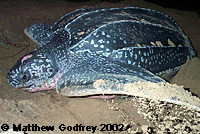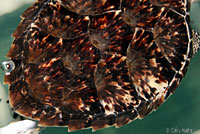Comparison of California Sea Turtles


Leatherback Sea Turtle - Dermochelys coriacea |
Pacific Hawksbill Sea Turtle - Eretmochelys imbricata bissa |
Loggerhead Sea Turtle - Caretta caretta |
Olive Ridley Sea Turtle - Lepidochelys olivacea |
|
The Leatherback's huge size, smooth leathery skin, and shell with 7 prominent lengthwise dorsal ridges, or keels, and no visible scutes, differentiate it from any other sea turtle. |
This is probably the most commonly-seen sea turtle in California waters. |
These pictures show an Atlantic Hawksbill, but there is no difference in appearance for our purposes. |
The largest sea turtle with a hard shell. |
The smallest sea turtle. |
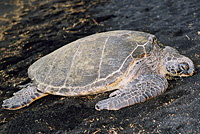 |
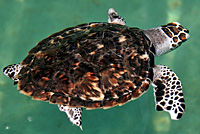 |
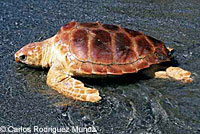 © Carlos Rodriguez Munoz © Carlos Rodriguez Munoz |
 © William Flaxington © William Flaxington |
|
 |
 |
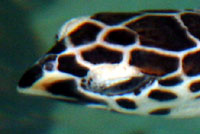 |
 |
 |
| Dorsal ridges. | The head is not as broad as that of the Loggerhead. | Long raptor-like snout |
Head is very broad. The shell is high in front. |
The head is not as broad as that of the Loggerhead. |
 |
 |
 |
 |
|
| One pair of pre-frontals | Two pairs of pre-frontals |
Two pairs of pre-frontals | Two pairs of pre-frontals | |
 |
 |
 © Carlos Rodriguez Munoz © Carlos Rodriguez Munoz |
 © William Flaxington © William Flaxington |
|
Four costal shields on each side. The first shield does not touch the nuchal. |
Four costal shields on each side |
5 or more costal shields on each side. The first shield touches the nuchal. |
5 - 9 costal shields on each side. The first shield touches the nuchal. |
|
 |
 |
|||
Marbled radiating pattern on the shell. The edge of the shell is serrated and the shields overlap like shingles. |
Shell is olive to gray in color, and smooth on adults. |
|||
 |
||||
Younger turtles have a mottled or radiating pattern on the shell, somewhat similar to the Hawksbill. |
||||
Leatherback Sea Turtle - Dermochelys coriacea |
Pacific Hawksbill Sea Turtle - Eretmochelys imbricata bissa |
Loggerhead Sea Turtle - Caretta caretta |
Olive Ridley Sea Turtle - Lepidochelys olivacea |
Return to the Top
© 2000 -

